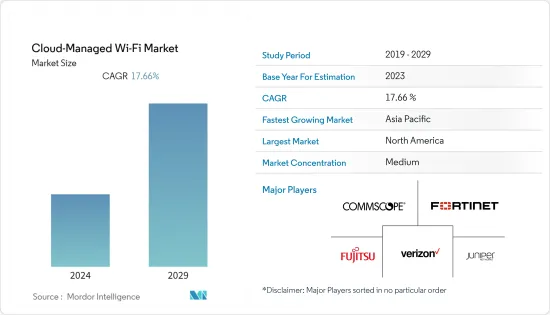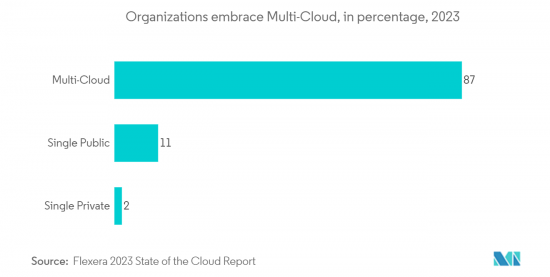 |
市场调查报告书
商品编码
1408571
云端管理 Wi-Fi:市场占有率分析、产业趋势/统计、成长预测,2024-2029 年Cloud-Managed Wi-Fi - Market Share Analysis, Industry Trends & Statistics, Growth Forecasts 2024 - 2029 |
||||||
※ 本网页内容可能与最新版本有所差异。详细情况请与我们联繫。
本财年云端管理Wi-Fi市场价值为53.1亿美元,预估未来五年将达119.7亿美元,预测期内复合年增长率为17.66%。

主要亮点
- 服务业对即时、更快、更安全连线的需求不断增长,这是推动云端管理 Wi-Fi 市场的关键因素。
- 云端管理的 Wi-Fi 可提高网路效率,同时协助系统整合和升级。它还监督可以在任何装置(包括智慧型手机、笔记型电脑和 PC)上存取热点和 WLAN 的网路。云端管理Wi-Fi解决方案因其配置、可靠性和成本效益而受到企业的欢迎。
- 此外,云端管理网路市场的发展是推动在管理网路服务中采用先进混合云端模型的趋势之一。混合云端管理网路消除了第三方进入,同时提供安全网路基础架构、连接和进阶经营模式等进阶功能。
- 云端基础的解决方案提供进阶分析和见解,帮助企业优化网路效能、解决问题并做出资料主导的决策。与其他云端服务和平台(例如 CRM 和行销工具)集成,可以提高客户参与并实现资料主导的行销。
- 此外,在云端储存网路资料和配置会引发安全性问题,因为它可能成为网路攻击的目标。确保强而有力的安全措施极为重要。此外,依赖云端服务意味着您的网路可用性取决于云端提供者的稳定性和执行时间。停机或中断可能会影响连线能力。
- COVID-19 的疫情对云端管理 Wi-Fi 市场产生了重大影响。随着越来越多的公司适应远距工作和数位转型,对可靠且扩充性的Wi-Fi 解决方案的需求不断增加。
云端管理 Wi-Fi 市场的趋势
Wi-Fi 6的发展将带动各产业服务模式的发展
- 云端管理的 Wi-Fi 6 技术提供了更高的效能和效率,使其成为寻求增强无线网路的企业和组织的热门选择。它速度更快,支援更多设备,并且改进了安全功能。
- 此外,视讯串流、线上游戏和扩增实境等高频宽应用程式的增加需要能够提供高速、低延迟连接的 Wi-Fi 网路。企业和组织需要可集中管理的强大且可扩充性的Wi-Fi 解决方案。云端管理的 Wi-Fi 6 系统提供集中管理、监控和故障排除功能,对企业具有吸引力。
- 除此之外,服务供应商还可以持续监控配备 Wi-Fi 6 的用户端设备的效能并远端检验客户服务等级。由于许多商业应用程式的资料消耗迅速增加,预计未来几年大型企业将需要高品质的 Wi-Fi 服务。
- 然而,随着公共 Wi-Fi 网路在各种企业和商业环境中变得越来越普及和广泛采用,企业利用 Wi-Fi 6 技术的机会越来越多。随着对无缝连接和高速互联网的需求不断增长,企业逐渐认识到需要为其客户提供可靠、高效和安全的无线网路。这进一步加速了市场的成长。
- 2022 年 5 月,诺基亚发布了诺基亚 DAC Wi-Fi,为多个产业提供连接资产的弹性,作为其数位转型的一部分。此外,诺基亚数位自动化云端 (DAC) 端到端工业级数数位化平台使 Wi-Fi 连接解决方案变得轻鬆可用。

亚太地区预计成长最快
- 随着亚太地区越来越多的人上网,对可靠、高速 Wi-Fi 连线的需求不断增加,从而推动了对云端管理 Wi-Fi 解决方案的需求。此外,该地区的许多企业正在经历数位转型,需要现代化、扩充性且集中管理的 Wi-Fi 基础设施。
- 亚太地区以其高科技基础设施和可靠性标准而闻名。云端管理的 Wi-Fi 提供强大、冗余且扩充性的网络,以确保不间断的连接。此外,企业通常需要可扩展的解决方案来应对需求的波动。云端管理的 Wi-Fi 可以快速扩展和缩减,适合各种规模的企业。
- 2022 年 12 月,作为数位新政 2.0 倡议的一部分,科学和资讯通信技术部宣布了一项关于元宇宙的泛政府战略。这项策略将有助于韩国更好地应对颠覆性创新和新兴技术,为未来做好准备。预计这将大幅促进该地区的市场成长。
- 超过 22 个国家已采用使用 6GHz 频段的 Wi-Fi 6E 系统运行,日本也在努力实现这一最新的 Wi-Fi 创新。截至2022年9月,随着日本开放6GHz频段,高通将提供完整的Wi-Fi 6E生态系统,大幅改善日本拥挤的环境。
- 总体而言,亚太地区的云端管理 Wi-Fi 市场预计将成长,因为它能够满足日益互联的世界中企业和组织不断变化的需求。
云端管理 Wi-Fi 产业概述
云端管理 Wi-Fi 市场目前的特点是整合缓慢,有多个主导厂商。其中少数主要参与者占了重要的市场占有率。此外,我们还看到了积极的活动,包括市场参与企业的合併、收购和大规模投资。这些都是为了加强我们的业务并扩大我们的业务范围以满足跨各种应用的不同客户需求而共同努力。
其他福利:
- Excel 格式的市场预测 (ME) 表
- 3 个月的分析师支持
目录
第一章简介
- 研究假设和市场定义
- 调查范围
第二章调查方法
第三章执行摘要
第四章市场洞察
- 市场概况
- 产业吸引力-波特五力分析
- 买方议价能力
- 供应商的议价能力
- 新进入者的威胁
- 替代品的威胁
- 竞争公司之间敌对关係的强度
- COVID-19 市场影响评估
第五章市场动态
- 市场驱动因素
- Wi-Fi 6的发展将带动各产业服务模式的成长
- 混合云端模式的上升趋势推动市场成长
- 市场抑制因素
- 资料安全和隐私问题
- 需要熟练的员工
第六章市场区隔
- 按成分
- 解决方案
- 服务
- 按最终用户产业
- 政府机关
- 卫生保健
- 零售
- 教育
- 资讯科技/通讯
- 其他的
- 按地区
- 北美洲
- 欧洲
- 亚太地区
- 拉丁美洲
- 中东/非洲
第七章 竞争形势
- 公司简介
- Cisco Meraki
- Ubiquiti Inc.
- CommScope Holding Company, Inc.
- Cambium Networks, Ltd.
- Fortinet, Inc.
- Juniper Networks, Inc.
- Tata Communications
- Fujitsu Limited
- Verizon
- Purple
第八章投资分析
第九章 市场机会及未来趋势

The cloud-managed Wi-Fi market is valued at USD 5.31 billion in the current year and is expected to register a CAGR of 17.66% during the forecasted period to become USD 11.97 billion by the next five years.
Key Highlights
- The rising need for immediate, quicker, and more secure connectivity in the services industry is the primary factor driving the Cloud Managed Wi-Fi Market.
- Cloud-managed Wi-Fi improves network efficiency while assisting with system integration and upgrades. They also oversee networks that let users access hotspots and WLANs on any device, including smartphones, laptops, and PCs. Due to their configuration, dependability, and exceptional cost-effectiveness, Cloud Managed Wi-Fi solutions have become popular among enterprises.
- In addition, the evolving cloud-managed networking market is one of the trends raising the adoption of advanced hybrid cloud models in managed networking services. Hybrid Cloud managed networking provides advanced features such as secure network infrastructure, connectivity, and advanced business models, along with eliminating third-party participation.
- Cloud-based solutions offer advanced analytics and insights, helping organizations optimize network performance, troubleshoot issues, and make data-driven decisions. Integration with other cloud services and platforms, such as CRM and marketing tools, offers improved customer engagement and data-driven marketing opportunities.
- In addition, storing network data and configurations in the Cloud raises security concerns, as it becomes a potential target for cyberattacks. Ensuring robust security measures is crucial. Also, dependence on cloud services means that network availability relies on the stability and uptime of cloud providers. Downtime or disruptions can affect connectivity.
- The COVID-19 pandemic had a significant impact on the cloud-managed Wi-Fi market. As more businesses adapted to remote work and digital transformation, the demand for reliable and scalable Wi-Fi solutions increased.
Cloud-Managed Wi-Fi Market Trends
Development of Wi-Fi 6 to enhance the growth of a service model across various industries
- Cloud-managed Wi-Fi 6 technology offers improved performance and efficiency, making it a popular choice for businesses and organizations looking to enhance their wireless networks. It provides faster speeds, better support for a large number of devices, and increased security features.
- Moreover, with the growth of bandwidth-intensive applications like video streaming, online gaming, and augmented reality, there's a need for Wi-Fi networks that can deliver high-speed, low-latency connections. Businesses and organizations require robust and scalable Wi-Fi solutions that can be centrally managed. Cloud-managed Wi-Fi 6 systems offer centralized control, monitoring, and troubleshooting capabilities, making them attractive for enterprises.
- In addition to this, the service providers can continuously monitor the performance of their Customer Premises Equipment with Wi-Fi 6 and verify the customer's service level remotely. Large enterprises are anticipated to have a requirement for high-quality Wi-Fi services in the upcoming years due to a surge in data consumption by many business applications.
- However, the growing proliferation and widespread adoption of public Wi-Fi networks in various businesses and commercial settings present a lucrative opportunity for enterprises to leverage Wi-Fi 6 technology. As the demand for seamless connectivity and high-speed internet continues to rise, businesses recognize the need to cater to their customers with reliable, efficient, and secure wireless networks. This further augments the market's growth.
- In May 2022, Nokia introduced the Nokia DAC Wi-Fi to provide more flexibility for several industries connecting assets as part of their digital transformation. Moreover, in the Nokia Digital Automation Cloud (DAC) end-to-end industrial-grade digitalization platform, the Wi-Fi connectivity solution will be easily available.

Asia-Pacific is Expected to Have the Fastest Growth Rate
- As more people in the Asia-Pacific region gain access to the internet, the demand for reliable and high-speed Wi-Fi connectivity has risen, driving the need for cloud-managed Wi-Fi solutions. Moreover, many businesses in the region are undergoing digital transformation, often requiring modern, scalable, and centrally managed Wi-Fi infrastructure.
- The Asia-Pacific region for its high-tech infrastructure and reliability standards. Cloud-managed Wi-Fi offers robust, redundant, and scalable networks, ensuring uninterrupted connectivity. Also, businesses often require scalable solutions to accommodate fluctuating demands. Cloud-managed Wi-Fi can quickly scale up or down, making it suitable for companies of all sizes.
- In December 2022, as part of the Digital New Deal 2.0 initiative, the Ministry of Science and ICT declared a pan-government strategy on metaverse. This strategy will assist South Korea to respond better to disruptive innovation and emerging new technologies and be prepared for the future. This is expected to enhance the market's growth within the region exponentially.
- More than 22 countries have adopted the operation of Wi-Fi 6E systems using the 6 GHz band, and Japan now joins the countries committed to delivering this latest Wi-Fi innovation. As of September 2022, Qualcomm will enable Japan with a Complete Wi-Fi 6E Ecosystem as the Country Opens 6 GHz Band, which will dramatically improve the congested environment in Japan.
- Overall, the cloud-managed Wi-Fi market in the Asia-Pacific region is poised for growth due to its ability to meet the evolving needs of businesses and organizations in an increasingly connected world.
Cloud-Managed Wi-Fi Industry Overview
The cloud-managed Wi-Fi market is currently characterized by moderate consolidation and features several prominent players. A handful of these major players command significant market share. Furthermore, the market is experiencing a flurry of activity with mergers, acquisitions, and substantial investments undertaken by key industry participants, all in a concerted effort to enhance their business operations and extend their reach to cater to diverse customer needs across various applications.
In November 2022, 11:11 Systems, a provider of managed infrastructure solutions, announced the successful completion of its acquisition of Sungard Availability Services' Recovery Services business and Sungard AS' Cloud and Managed Services (CMS) business.
In January 2022, Linksys unveiled the Wi-Fi 6 Cloud Managed Access Point, specifically designed for areas requiring robust support for a multitude of concurrent client connections. These Wi-Fi 6 Cloud-managed access points are equipped with 4x4 antennas, which significantly enhance both security and speed. The cloud-based control plane facilitates seamless ZeroTouch provisioning, efficient configuration management, and streamlined monitoring, all powered by a cloud-native operating system running on the units.
Additional Benefits:
- The market estimate (ME) sheet in Excel format
- 3 months of analyst support
TABLE OF CONTENTS
1 INTRODUCTION
- 1.1 Study Assumptions and Market Definition
- 1.2 Scope of the Study
2 RESEARCH METHODOLOGY
3 EXECUTIVE SUMMARY
4 MARKET INSIGHTS
- 4.1 Market Overview
- 4.2 Industry Attractiveness - Porter's Five Forces Analysis
- 4.2.1 Bargaining Power of Buyers
- 4.2.2 Bargaining Power of Suppliers
- 4.2.3 Threat of New Entrants
- 4.2.4 Threat of Substitutes
- 4.2.5 Intensity of Competitive Rivalry
- 4.3 Assessment of the Impact of COVID-19 on the Market
5 MARKET DYNAMICS
- 5.1 Market Drivers
- 5.1.1 Development of Wi-Fi 6 to enhance the growth of a service model across various industries
- 5.1.2 Increasing trend of Hybrid Cloud Model to augment market growth
- 5.2 Market Restraints
- 5.2.1 Data security and privacy concerns
- 5.2.2 Requirement of skilled staff
6 MARKET SEGMENTATION
- 6.1 By Component
- 6.1.1 Solution
- 6.1.2 Services
- 6.2 By End-User Industry
- 6.2.1 Government
- 6.2.2 Healthcare
- 6.2.3 Retail
- 6.2.4 Education
- 6.2.5 IT & Telecommunications
- 6.2.6 Other End-User Industries
- 6.3 By Geography
- 6.3.1 North America
- 6.3.2 Europe
- 6.3.3 Asia-Pacific
- 6.3.4 Latin America
- 6.3.5 Middle East and Africa
7 COMPETITIVE LANDSCAPE
- 7.1 Company Profiles
- 7.1.1 Cisco Meraki
- 7.1.2 Ubiquiti Inc.
- 7.1.3 CommScope Holding Company, Inc.
- 7.1.4 Cambium Networks, Ltd.
- 7.1.5 Fortinet, Inc.
- 7.1.6 Juniper Networks, Inc.
- 7.1.7 Tata Communications
- 7.1.8 Fujitsu Limited
- 7.1.9 Verizon
- 7.1.10 Purple









